check engine Alfa Romeo 147 2010 Owner handbook (in English)
[x] Cancel search | Manufacturer: ALFA ROMEO, Model Year: 2010, Model line: 147, Model: Alfa Romeo 147 2010Pages: 291, PDF Size: 5.52 MB
Page 229 of 291
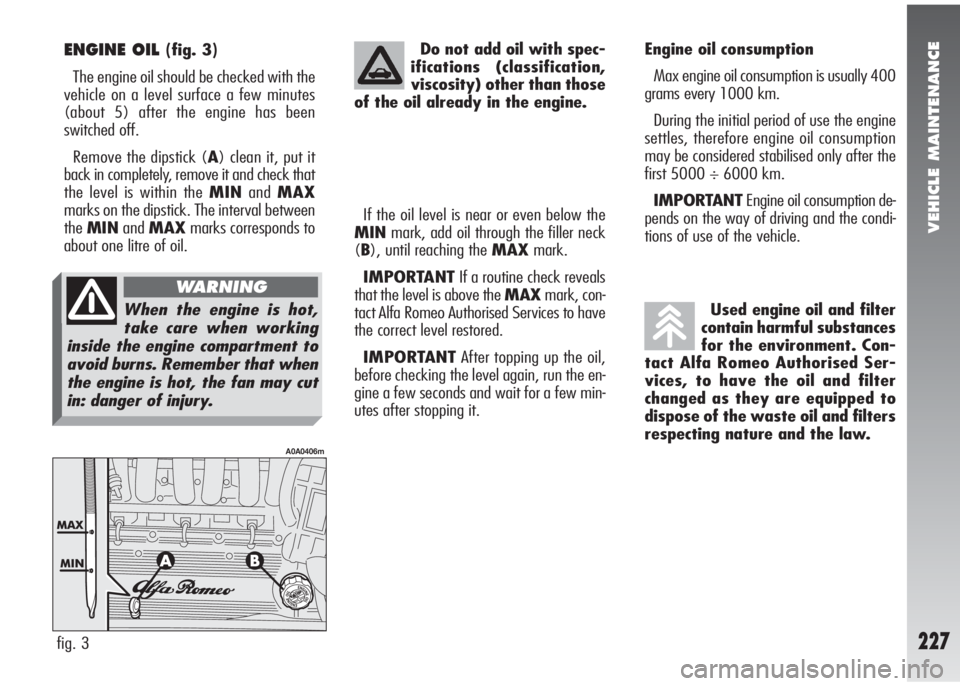
VEHICLE MAINTENANCE
227
Used engine oil and filter
contain harmful substances
for the environment. Con-
tact Alfa Romeo Authorised Ser-
vices, to have the oil and filter
changed as they are equipped to
dispose of the waste oil and filters
respecting nature and the law.
ENGINE OIL (fig. 3)
The engine oil should be checked with the
vehicle on a level surface a few minutes
(about 5) after the engine has been
switched off.
Remove the dipstick (A) clean it, put it
back in completely, remove it and check that
the level is within the MINandMAX
marks on the dipstick. The interval between
theMINandMAXmarks corresponds to
about one litre of oil.If the oil level is near or even below the
MINmark, add oil through the filler neck
(B), until reaching the MAXmark.
IMPORTANTIf a routine check reveals
that the level is above the MAXmark, con-
tact Alfa Romeo Authorised Services to have
the correct level restored.
IMPORTANTAfter topping up the oil,
before checking the level again, run the en-
gine a few seconds and wait for a few min-
utes after stopping it.Engine oil consumption
Max engine oil consumption is usually 400
grams every 1000 km.
During the initial period of use the engine
settles, therefore engine oil consumption
may be considered stabilised only after the
first 5000 ÷ 6000 km.
IMPORTANTEngine oil consumption de-
pends on the way of driving and the condi-
tions of use of the vehicle.
fig. 3
A0A0406m
Do not add oil with spec-
ifications (classification,
viscosity) other than those
of the oil already in the engine.
When the engine is hot,
take care when working
inside the engine compartment to
avoid burns. Remember that when
the engine is hot, the fan may cut
in: danger of injury.
WARNING
Page 230 of 291

VEHICLE MAINTENANCE
228
SELESPEED TRANSMISSION
OIL
(fig. 4)
The Selespeed transmission oil should be
checked with the vehicle on a level surface
and with the engine stopped and cold.
To check the level, proceed as follows:
– turn the ignition key to MAR;
– disconnect the breather tube and re-
move the cap (A) checking that the level
corresponds with the MAXmark on the dip-
stick integrated with the cap;– if the oil is below the MAXmark, top
up to reach the correct level;
– after refitting the cap, insert the breather
tube firmly on the housing on the cap and
turn the ignition key to STOP.
Used gearbox oil contains
dangerous substances for
the environment. For chang-
ing the oil we advise contacting Al-
fa Romeo Authorised Services who
are equipped for disposing of used
oil respecting nature and the law.Do not add oil with spec-
ifications other than that
already in the gearbox.
fig. 4
A0A00197m
Be very careful working in-
side the engine compart-
ment if the engine is hot: danger of
burns. Remember that the fan may
cut in if the engine is very hot: dan-
ger of injury.
WARNING
Page 231 of 291
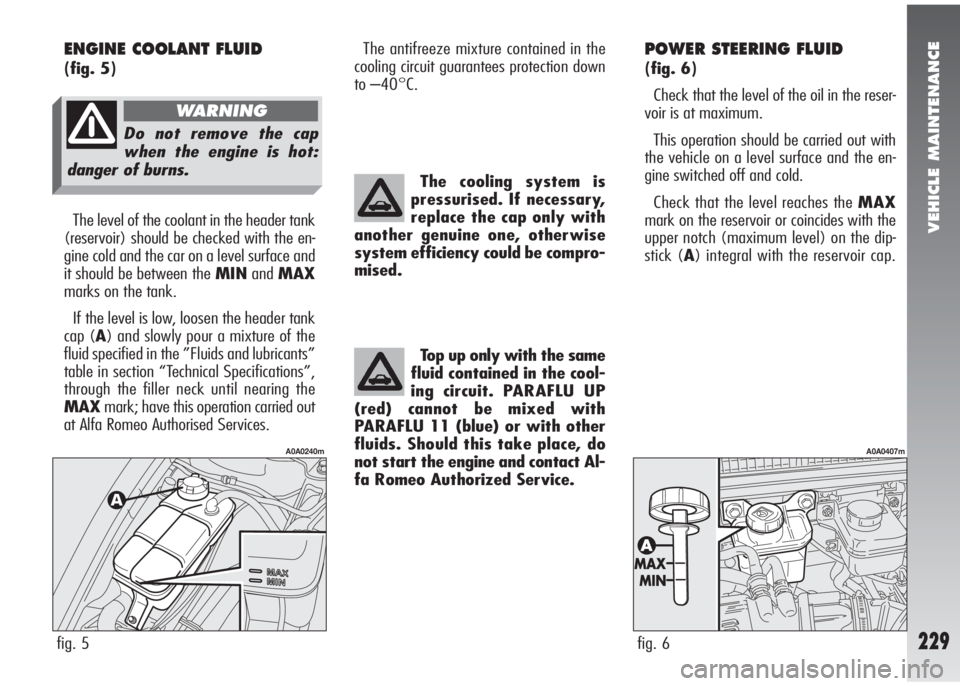
VEHICLE MAINTENANCE
229
POWER STEERING FLUID
(fig. 6)
Check that the level of the oil in the reser-
voir is at maximum.
This operation should be carried out with
the vehicle on a level surface and the en-
gine switched off and cold.
Check that the level reaches the MAX
mark on the reservoir or coincides with the
upper notch (maximum level) on the dip-
stick (A) integral with the reservoir cap. The cooling system is
pressurised. If necessary,
replace the cap only with
another genuine one, otherwise
system efficiency could be compro-
mised.
Top up only with the same
fluid contained in the cool-
ing circuit. PARAFLU UP
(red) cannot be mixed with
PARAFLU 11 (blue) or with other
fluids. Should this take place, do
not start the engine and contact Al-
fa Romeo Authorized Service.
fig. 6
A0A0407m
ENGINE COOLANT FLUID
(fig. 5)
The level of the coolant in the header tank
(reservoir) should be checked with the en-
gine cold and the car on a level surface and
it should be between the MINandMAX
marks on the tank.
If the level is low, loosen the header tank
cap (A) and slowly pour a mixture of the
fluid specified in the ”Fluids and lubricants”
table in section “Technical Specifications”,
through the filler neck until nearing the
MAXmark; have this operation carried out
at Alfa Romeo Authorised Services.
fig. 5
A0A0240m
The antifreeze mixture contained in the
cooling circuit guarantees protection down
to –40°C.
Do not remove the cap
when the engine is hot:
danger of burns.
WARNING
Page 232 of 291
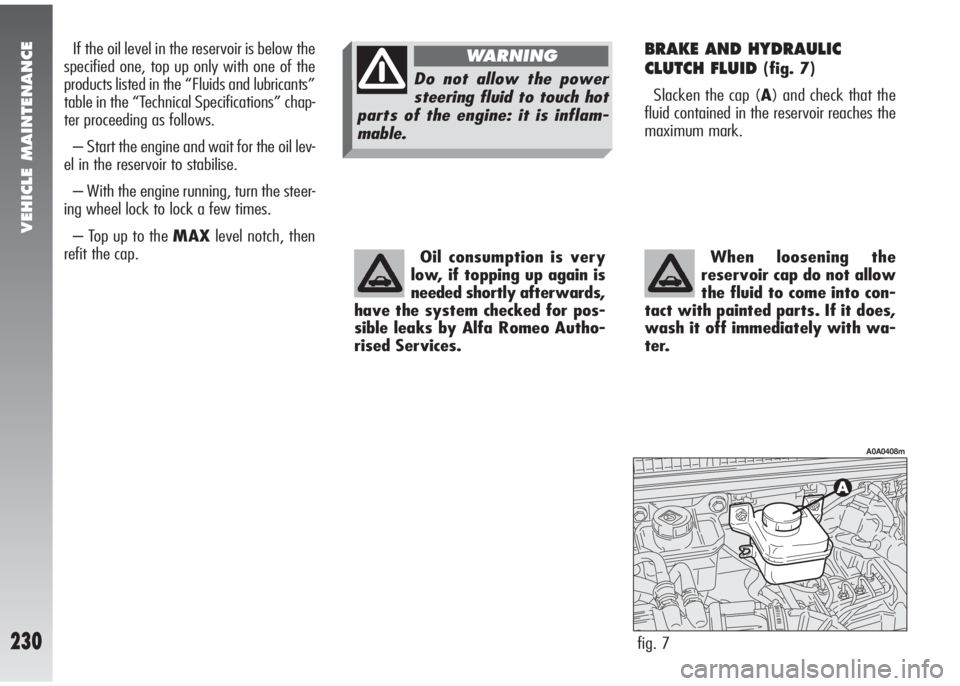
VEHICLE MAINTENANCE
230
If the oil level in the reservoir is below the
specified one, top up only with one of the
products listed in the “Fluids and lubricants”
table in the “Technical Specifications” chap-
ter proceeding as follows.
– Start the engine and wait for the oil lev-
el in the reservoir to stabilise.
– With the engine running, turn the steer-
ing wheel lock to lock a few times.
– Top up to the MAXlevel notch, then
refit the cap.
Oil consumption is very
low, if topping up again is
needed shortly afterwards,
have the system checked for pos-
sible leaks by Alfa Romeo Autho-
rised Services.BRAKE AND HYDRAULIC
CLUTCH FLUID
(fig. 7)
Slacken the cap (A) and check that the
fluid contained in the reservoir reaches the
maximum mark.
fig. 7
A0A0408m
When loosening the
reservoir cap do not allow
the fluid to come into con-
tact with painted parts. If it does,
wash it off immediately with wa-
ter.
Do not allow the power
steering fluid to touch hot
parts of the engine: it is inflam-
mable.
WARNING
Page 233 of 291
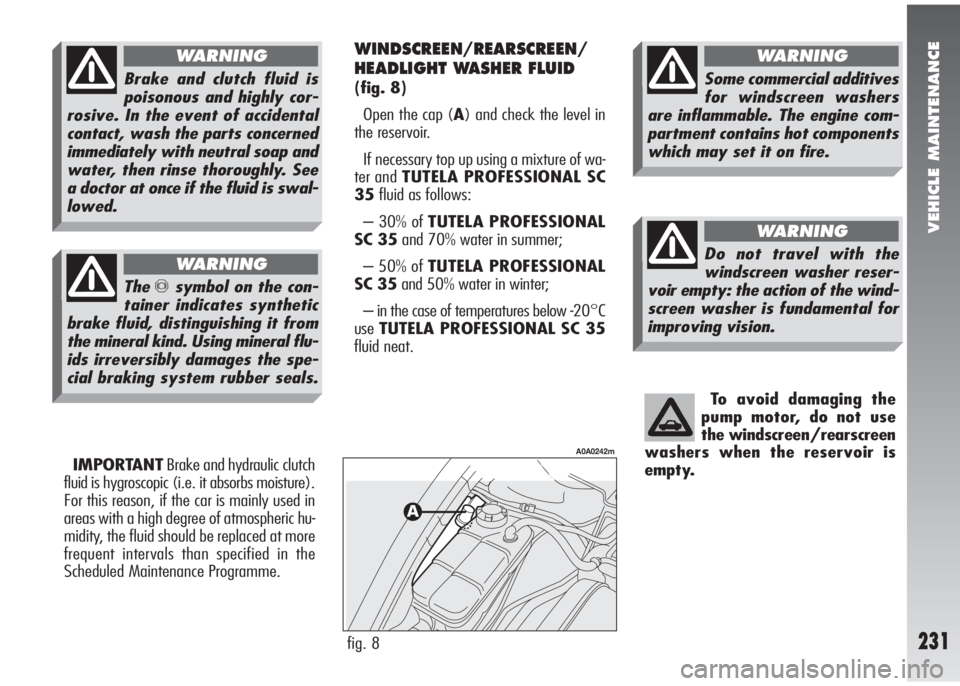
VEHICLE MAINTENANCE
231
To avoid damaging the
pump motor, do not use
the windscreen/rearscreen
washers when the reservoir is
empty.
IMPORTANTBrake and hydraulic clutch
fluid is hygroscopic (i.e. it absorbs moisture).
For this reason, if the car is mainly used in
areas with a high degree of atmospheric hu-
midity, the fluid should be replaced at more
frequent intervals than specified in the
Scheduled Maintenance Programme.
WINDSCREEN/REARSCREEN/
HEADLIGHT WASHER FLUID
(fig. 8)
Open the cap (A) and check the level in
the reservoir.
If necessary top up using a mixture of wa-
ter and TUTELA PROFESSIONAL SC
35fluid as follows:
– 30% of TUTELA PROFESSIONAL
SC 35and 70% water in summer;
– 50% of TUTELA PROFESSIONAL
SC 35and 50% water in winter;
– in the case of temperatures below -20°C
useTUTELA PROFESSIONAL SC 35
fluid neat.
fig. 8
A0A0242m
Theπsymbol on the con-
tainer indicates synthetic
brake fluid, distinguishing it from
the mineral kind. Using mineral flu-
ids irreversibly damages the spe-
cial braking system rubber seals.
WARNING
Brake and clutch fluid is
poisonous and highly cor-
rosive. In the event of accidental
contact, wash the parts concerned
immediately with neutral soap and
water, then rinse thoroughly. See
a doctor at once if the fluid is swal-
lowed.
WARNING
Do not travel with the
windscreen washer reser-
voir empty: the action of the wind-
screen washer is fundamental for
improving vision.
WARNING
Some commercial additives
for windscreen washers
are inflammable. The engine com-
partment contains hot components
which may set it on fire.
WARNING
Page 234 of 291
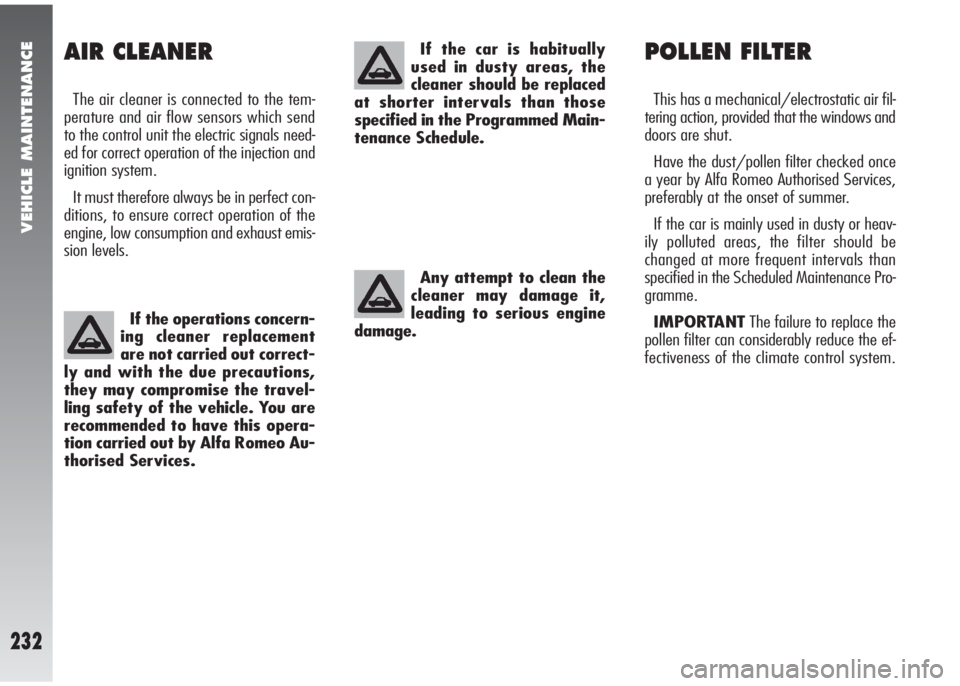
VEHICLE MAINTENANCE
232
AIR CLEANER
The air cleaner is connected to the tem-
perature and air flow sensors which send
to the control unit the electric signals need-
ed for correct operation of the injection and
ignition system.
It must therefore always be in perfect con-
ditions, to ensure correct operation of the
engine, low consumption and exhaust emis-
sion levels.
If the operations concern-
ing cleaner replacement
are not carried out correct-
ly and with the due precautions,
they may compromise the travel-
ling safety of the vehicle. You are
recommended to have this opera-
tion carried out by Alfa Romeo Au-
thorised Services.
Any attempt to clean the
cleaner may damage it,
leading to serious engine
damage.If the car is habitually
used in dusty areas, the
cleaner should be replaced
at shorter intervals than those
specified in the Programmed Main-
tenance Schedule.
POLLEN FILTER
This has a mechanical/electrostatic air fil-
tering action, provided that the windows and
doors are shut.
Have the dust/pollen filter checked once
a year by Alfa Romeo Authorised Services,
preferably at the onset of summer.
If the car is mainly used in dusty or heav-
ily polluted areas, the filter should be
changed at more frequent intervals than
specified in the Scheduled Maintenance Pro-
gramme.
IMPORTANTThe failure to replace the
pollen filter can considerably reduce the ef-
fectiveness of the climate control system.
Page 237 of 291
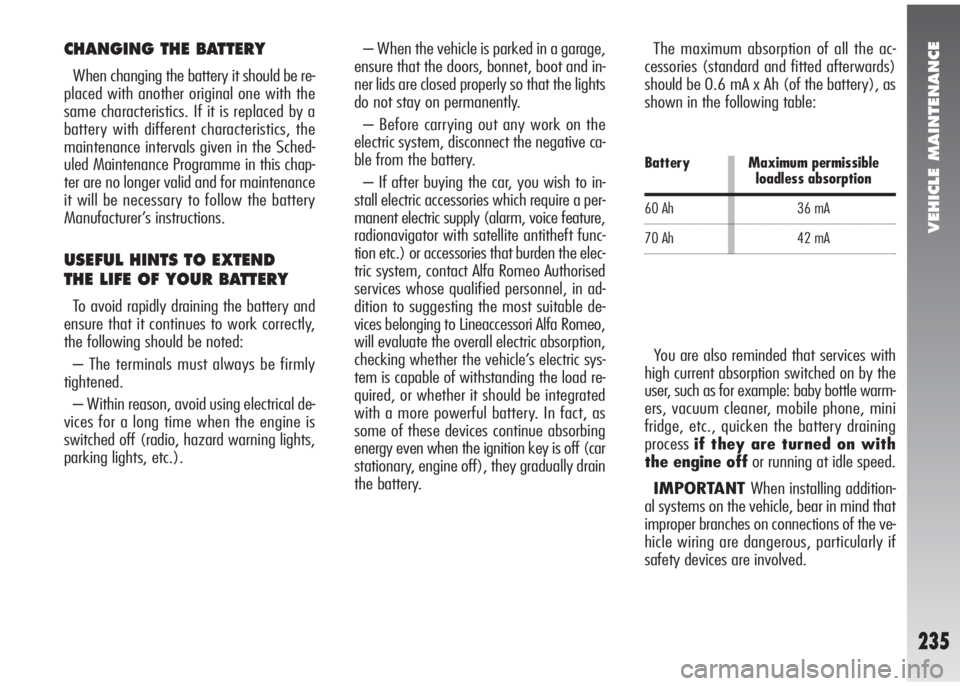
VEHICLE MAINTENANCE
235
You are also reminded that services with
high current absorption switched on by the
user, such as for example: baby bottle warm-
ers, vacuum cleaner, mobile phone, mini
fridge, etc., quicken the battery draining
processif they are turned on with
the engine offor running at idle speed.
IMPORTANT When installing addition-
al systems on the vehicle, bear in mind that
improper branches on connections of the ve-
hicle wiring are dangerous, particularly if
safety devices are involved.
Battery
60 Ah
70 AhMaximum permissible
loadless absorption
36 mA
42 mA
The maximum absorption of all the ac-
cessories (standard and fitted afterwards)
should be 0.6 mA x Ah (of the battery), as
shown in the following table:CHANGING THE BATTERY
When changing the battery it should be re-
placed with another original one with the
same characteristics. If it is replaced by a
battery with different characteristics, the
maintenance intervals given in the Sched-
uled Maintenance Programme in this chap-
ter are no longer valid and for maintenance
it will be necessary to follow the battery
Manufacturer’s instructions.
USEFUL HINTS TO EXTEND
THE LIFE OF YOUR BATTERY
To avoid rapidly draining the battery and
ensure that it continues to work correctly,
the following should be noted:
– The terminals must always be firmly
tightened.
– Within reason, avoid using electrical de-
vices for a long time when the engine is
switched off (radio, hazard warning lights,
parking lights, etc.).– When the vehicle is parked in a garage,
ensure that the doors, bonnet, boot and in-
ner lids are closed properly so that the lights
do not stay on permanently.
– Before carrying out any work on the
electric system, disconnect the negative ca-
ble from the battery.
– If after buying the car, you wish to in-
stall electric accessories which require a per-
manent electric supply (alarm, voice feature,
radionavigator with satellite antitheft func-
tion etc.) or accessories that burden the elec-
tric system, contact Alfa Romeo Authorised
services whose qualified personnel, in ad-
dition to suggesting the most suitable de-
vices belonging to Lineaccessori Alfa Romeo,
will evaluate the overall electric absorption,
checking whether the vehicle’s electric sys-
tem is capable of withstanding the load re-
quired, or whether it should be integrated
with a more powerful battery. In fact, as
some of these devices continue absorbing
energy even when the ignition key is off (car
stationary, engine off), they gradually drain
the battery.
Page 238 of 291
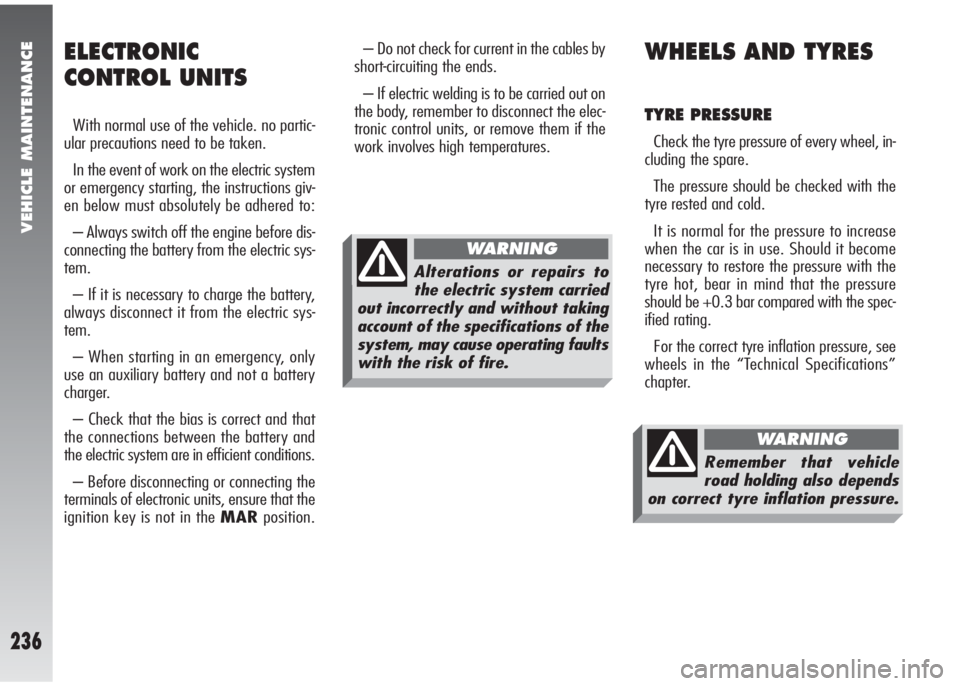
VEHICLE MAINTENANCE
236
– Do not check for current in the cables by
short-circuiting the ends.
– If electric welding is to be carried out on
the body, remember to disconnect the elec-
tronic control units, or remove them if the
work involves high temperatures.ELECTRONIC
CONTROL UNITS
With normal use of the vehicle. no partic-
ular precautions need to be taken.
In the event of work on the electric system
or emergency starting, the instructions giv-
en below must absolutely be adhered to:
– Always switch off the engine before dis-
connecting the battery from the electric sys-
tem.
– If it is necessary to charge the battery,
always disconnect it from the electric sys-
tem.
– When starting in an emergency, only
use an auxiliary battery and not a battery
charger.
– Check that the bias is correct and that
the connections between the battery and
the electric system are in efficient conditions.
– Before disconnecting or connecting the
terminals of electronic units, ensure that the
ignition key is not in the MARposition.
WHEELS AND TYRES
TYRE PRESSURE
Check the tyre pressure of every wheel, in-
cluding the spare.
The pressure should be checked with the
tyre rested and cold.
It is normal for the pressure to increase
when the car is in use. Should it become
necessary to restore the pressure with the
tyre hot, bear in mind that the pressure
should be +0.3 bar compared with the spec-
ified rating.
For the correct tyre inflation pressure, see
wheels in the “Technical Specifications”
chapter.
Alterations or repairs to
the electric system carried
out incorrectly and without taking
account of the specifications of the
system, may cause operating faults
with the risk of fire.
WARNING
Remember that vehicle
road holding also depends
on correct tyre inflation pressure.
WARNING
Page 242 of 291

VEHICLE MAINTENANCE
240
HEADLIGHT WASHERS
Regularly check that the spray jets are in-
tact and clean (fig. 17).
If it is necessary to direct the jet, contact
an Alfa Romeo Authorised Service.
BODYWORK
PROTECTION FROM
ATMOSPHERIC AGENTS
The main causes of corrosion are:
– atmospheric pollution
– salty air and humidity (coastal areas, or
hot humid climates)
– seasonal environment conditions.
Not to be underestimated is also the abra-
sive action of wind-borne atmospheric dust
and sand and mud and gravel raised by oth-
er vehicles.
On your
Alfa 147 GTA, Alfa Romeo
has implemented the best manufacturing
technologies to effectively protect the body-
work against corrosion.
These include:
– Painting products and systems which
give the vehicle particular resistance to cor-
rosion and abrasion.
– Use of galvanised (or pretreated) steel
sheets, with high resistance to corrosion.
– Spraying the underbody, engine com-
partment, wheel arches and other parts with
highly protective wax products.
fig. 17
A0A0425m
– Spraying of plastic parts, with a protec-
tive function, in the more exposed points:
underdoor, inner wheel arch linings, etc.
– Use of “open” boxed sections to pre-
vent condensation and pockets of moisture
from triggering rust inside.
VEHICLE EXTERIOR AND
UNDERBODY WARRANTY
TheAlfa 147 GTAis guaranteed
against perf oration due to rust of any orig-
inal element of the structure or body. For the
general terms of this warranty, refer to the
Warranty Booklet.
Page 244 of 291

VEHICLE MAINTENANCE
242
CLEANING LEATHER SEATS
– Remove dried on dirt with a lightly
moistened chamois leather or cloth with-
out pressing too hard.
– Remove liquid and grease stains with
a dry absorbent cloth without rubbing. Then
wipe with a soft cloth or chamois leather
with water and neutral soap. If the stain per-
sists, use specific products, carefully follow-
ing the instructions for use.
IMPORTANTNever use alcohol. Make
sure that cleaning products do not contain
alcohol and alcohol derivatives even at low
strength.
INTERIOR PLASTIC PARTS
Use appropriate products designed to pre-
serve the appearance of components.
IMPORTANTNever use spirit or petro-
leum to clean the instrument cluster. Engine compartment
At the end of the winter the engine com-
partment should be carefully washed, with-
out directing the jet against electronic con-
trol units. Contact a specialised workshop to
have this done.
INTERIOR FITTINGS
Periodically check that water is not trapped
under the mats (due to water dripping off
shoes, umbrellas, etc.) which could cause ox-
idisation of the sheet metal.
Detergents cause water
pollution. Therefore the en-
gine compartment should
be washed in areas equipped for
collecting and purifying the liquid
used in the washing process.
IMPORTANTThe vehicle should washed
with the engine cold and the ignition key at
STOP. After washing make sure that the
various protections (e.g. rubber caps and
various covers) have not been damaged or
removed.CLEANING SEATS AND FABRIC
AND VELVET PARTS
– Use a soft brush or vacuum cleaner to
remove dust. Velvet is cleaned better if the
brush is moistened.
– Rub the seats with a sponge moistened
with a solution of water and neutral deter-
gent.
Never use inflammable
products like fuel oil ether
or rectified petrol for cleaning inside
the car. The electrostatic charges
generated when rubbing to clean
may cause fire.
WARNING
Do not keep aerosol cans in
the car. They might ex-
plode. Aerosol cans must never be
exposed to a temperature above
50°C. The temperature inside the
car exposed to the sun may go well
beyond that figure.
WARNING